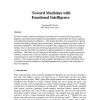Free Online Productivity Tools
i2Speak
i2Symbol
i2OCR
iTex2Img
iWeb2Print
iWeb2Shot
i2Type
iPdf2Split
iPdf2Merge
i2Bopomofo
i2Arabic
i2Style
i2Image
i2PDF
iLatex2Rtf
Sci2ools
ICINCO
2004
2004
Toward Machines with Emotional Intelligence
For half a century, artificial intelligence researchers have focused on giving machines linguistic and mathematical-logical reasoning abilities, modeled after the classic linguistic and mathematical-logical intelligences. This chapter describes new research that is giving machines (including software agents, robotic pets, desktop computers, and more) skills of emotional intelligence. Machines have long been able to appear as if they have emotional feelings, but now machines are also being programmed to learn when and how to display emotion in ways that enable the machine to appear empathetic or otherwise emotionally intelligent. Machines are now being given the ability to sense and recognize expressions of human emotion such as interest, distress, and pleasure, with the recognition that such communication is vital for helping machines choose more helpful and less aggravating behavior. This chapter presents several examples illustrating new and forthcoming forms of machine emotional in...
Artificial Intelligence Researchers | Emotional Intelligence | ICINCO 2004 | ICINCO 2007 | Machine |
| Added | 31 Oct 2010 |
| Updated | 31 Oct 2010 |
| Type | Conference |
| Year | 2004 |
| Where | ICINCO |
| Authors | Rosalind W. Picard |
Comments (0)

